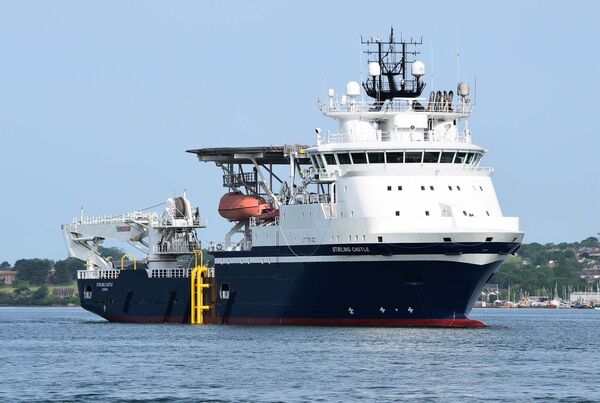
Stirling Castle has started sea trials with the RFA after completing its conversion into a mother ship for offboard autonomous mine countermeasure payloads. (RFA Nostalgia)
The UK Royal Navy's (RN's) new minehunting mother ship started sea trials with Royal Fleet Auxiliary (RFA) personnel after completing its military conversion from an oil rig offshore support vessel (OSV).
Stirling Castle (ex-MV Island Crown ) was purchased second-hand from Island Offshore Management for GBP40 million (USD49.3 million) to serve as a host platform for offboard autonomous mine countermeasure payloads.
The ship arrived at His Majesty's Naval Base (HMNB), Devonport, from Norway in late January to undergo its conversion. Modification work has been relatively minimal aside from the installation of specific military equipment for its new role.
The trials and RFA crew training period are expected to continue for the next couple of months, with a view to achieving initial operating capability in July–August 2023. The initial emphasis of trials will be on learning how best to run and maintain the 6,000 tonne vessel, test safety systems, and effectively write the instruction/operators' manual, Captain Ali Clack, the ship's commanding officer said.
Once in service, Stirling Castle will deploy unmanned systems being delivered under Block 1 of the RN's Mine Hunting Capability (MHC) programme, including the joint French-UK Maritime Mine Counter Measures (MMCM) system being delivered by Thales, the Combined Influence Sweep system delivered by Atlas Elektronik UK, and medium autonomous underwater vehicles (MAUVs) also being delivered by Atlas Elektronik.
The OSV was earlier operated as a walk-to-work (WTW) maintenance and subsea support vessel. It has an overall length of 96.8 m and is equipped with a 561 m² cargo deck and a helideck, a subsea crane, and can accommodate 100 personnel.
Looking to read the full article?
Gain unlimited access to Janes news and more...







